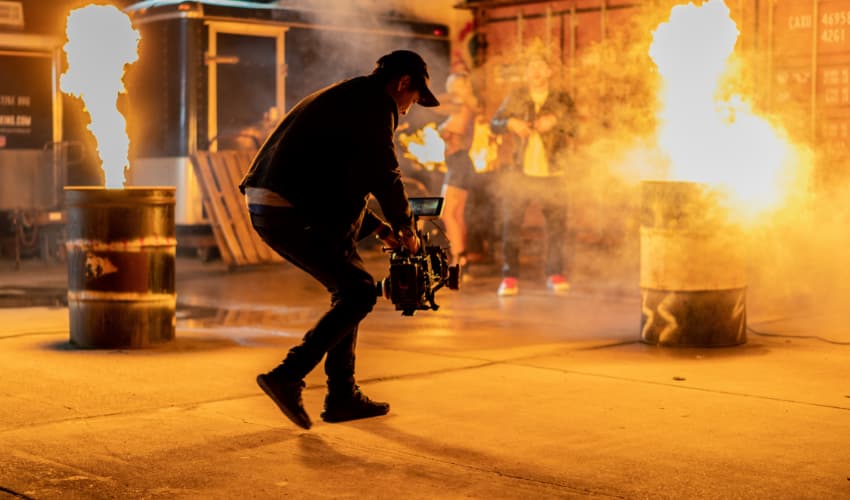There are no specific set of strict rules when it come to directing and creating your own music video because a huge part of the craft rests on creativity.
Whether you’re making a music video for a school project, a small business promotion campaign material, or your own band’s promotion, there is a common template to follow so that you don’t waste resources and create a successful music video.
Shooting music videos take a lot of time, effort, and money, so it is critical to plan well and be prepared.
Before you begin shooting those videos, it is vital to remember that creativity and imagination play an important role in the success of your music videos. Sky’s the limit when it comes to imagination, so go bold, think big, and don’t be afraid to let loose. Holding back for fear of other people’s comments will just curb your style and impair your vision. Do what you think and feel is right, so you can make the best music video of your life.
Tips to Shooting a Music Video
1. The Song
This is a pretty obvious step and is the most critical component of making a music video, but it is one worth repeating because many newbie musicians take their song choice for granted. All the success of your music video will depend on your song. You have to to make sure that your song composition is polished and fine-tuned to perfection before you advance to the next step, which is your videos. Test out your own song on different crowds to see how well they respond to it. Make the necessary tweaks and adjustments if needed.
2. Brain Storm
What is will be the theme of your music video? There are generally three types of music videos: performance, narrative, and concept. Which approach will you be taking to tell you story? List down all your ideas. You have to decide, which among these three will be your thrust.
Performance videos are videos that generally showcase the artist in a concert type setting. They typically just sing or play instruments while the camera rolls. They perform, hence the name of this category. There’s not much flare or fancy. It is all about giving a good, quality performance, which gives these types of music videos this the most realistic feel. A performance based music video gives the listeners the vibe that they are there listening live to the band or artist play. To illustrate, think of the Beatles Don’t Let Me Down music video on a rooftop building.
A narrative music video tells a story. Think of Taylor Swift’s Love Story or You Belong with Me. All these have a plot interspersed with her performance. A narrative music video needs a good, interesting story line that will go along with the song words. A narrative based music video has a film like vibe to it, with various settings or location shoots, making it a bit more expensive to shoot. You will need quite a bit of characters and props to make this happen.
Concept music videos, on the other hand have no story lines. Sometimes, there is a little bit of performance interspersed in it. But usually, the images that are depicted have no relationship to the song. The images used either have thematic and/or symbolic representation. Think fields of grass, birds flying around, ocean waves, and other kinds of imagery that evoke feeling. Concept music videos can also choose to play with lighting such as utilising dark shadows to give an eerie vibe or using psychedelic colours and abstract images. The whole point of this is to create a mood. An example of this kind of video is Best of You by Foo Fighters.
3. Your Budget
Everything hinges on how much you are willing to spend. Your budget will determine if you can afford one or more cameras. It can also indicate if you can hire a professional post-production company. This is the time to be honest with yourself and your group mates. How much are you really willing to spend? Choosing to borrow equipment, asking friends to be your actors, doing your own post production, or accessing a free location will help curb some expenses.
4. The Storyboard
This is your plan of action on what you expect to happen during the shoot. It is akin to a script when making films. This story board gives your entire production direction. It is something concrete that your team can aspire for and work on to reach your goals. The storyboard will help you flesh out requirements such as: scenes to be shot, costumes needed, number of artists, locations to be used, gear needed, and the like. Without proper planning, then you are planning to fail your music video production. Having this set plan will not just give your team direction, but it will also help you with your budget allocation because you can more or less anticipate your needs. Expectations are set in drafting storyboards so be sure to never skip this part.
5. Shoot Location
Scout the location before your start filming so you can get the right gear ready. Some locations have low lights, so you will need to bring additional lights. With this, you will also need to consider the availability of electrical supply. If unavailable, you have to pack a lot of batteries to sustain your shoot. Often, you can get free locations like in school campuses, public parks, churches, and the like. But before you proceed, you have to check with the local authorities because some areas may require a permit. The last thing you want to happen is to begin shooting only to be told that you need to stop because you don’t have the rights to shoot in that location. Mitigate this problem by preparing ahead of time. Remember to take photos of your prospective shoot location when you do your scouting work so you can match these up with your storyboard.
6. Gearing Up
If you are an amateur production, using ordinary video cameras or even your camera phone will do the trick. But of course, if you want professional quality, you will have to go for the big professional equipment. Since these are expensive, you may need o rent these. Aside from this, you also need to rent wash lights, spot lights, diffusers, and so on. If your budget is limited, working with natural light during the day may be your best bet.
7. The Right Actors
You need the perfect actors to make your music video come alive. If you need people to dance, then you have iron out the choreography ahead of time, too. On top of that, you need them fit their costumes and other paraphernalia they will use on the day of the actual shoot. It would be prudent to have quick practices the day before the shoot to ensure that all the intricate elements that can make or break your music video are ironed out. All these are details that you need to work on before you start filming so that you can eliminate potential delays and headaches.
8. Shooting
Be sure to prep everything so that you are ready on the day of the actual shoot. Keep a good attitude because this will affect the work flow and the final outcome. Take as many footage as you possibly can, so you will have plenty of material to work with when the time comes for you to edit the video.
9. Post Production Issues
This is a critical component post shoot. Dubbing is one consideration that you have to take because the last thing you want is your audio and video not in sync. Then comes the arduous task of splicing and weaving together hours of video footage and reducing it to a mere three minutes. You will need access to high end video editing software like Avid, Adobe Premier, After Effects, or Final Cut Pro. But for school projects, Windows Movie Maker or i-Movie will be more than enough.
Here, you can put in video effects, fix the tone of the images, edit sequences to give the right feel, and the like. It is important to take time to do your post production and editing work to make sure you come up with a quality video that people will appreciate and love.
Now that you have finished making your whole video, it is critical to promote it. After all, the whole point of crafting a whole music video is to expand your band’s reach. Make sure that you share your music videos in as many social media apps as you can. Be sure to create engagement with your audience, so they will be compelled to like, share, and comment in your videos that you have worked painstakingly hard on to produce.


